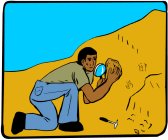
Worksheets and No Prep Teaching Resources
Reading Comprehension Worksheets
Careers in Science
Labor Day

Careers in Science
 Worksheets and No Prep Teaching Resources Reading Comprehension Worksheets Careers in Science Labor Day |
 Careers in Science |
| edHelper's suggested reading level: | grades 5 to 8 | |
| Flesch-Kincaid grade level: | 7.43 |
|
What Is a Geologist?
By Cindy Grigg |

|
 1 A geologist is a person who studies the earth. Geologists study the structure of the Earth, or how it is made, the origin, or the beginning of the Earth, and its history. Geologists study rocks, soil, fossils, mountains, and earthquakes.
1 A geologist is a person who studies the earth. Geologists study the structure of the Earth, or how it is made, the origin, or the beginning of the Earth, and its history. Geologists study rocks, soil, fossils, mountains, and earthquakes. |
Create Weekly Reading Books
Prepare for an entire week at once! |
| Leave your feedback on What Is a Geologist? (use this link if you found an error in the story) |
 |
Careers in Science
|
 |
Labor Day
|
 |
Science
|